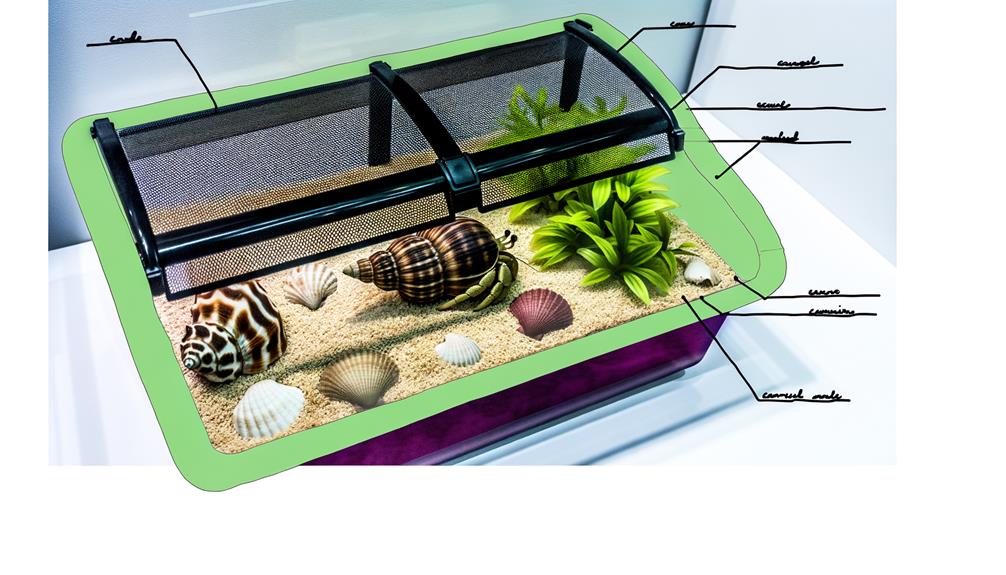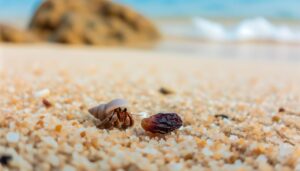Do Alewife Feed on Mud Crabs?
To create a DIY hermit crab tank lid, you'll need materials like aluminum, mesh wire, and marine-grade silicone. Start by measuring your tank's dimensions accurately.
Cut the frame using a hacksaw, making sure squared corners. Clean surfaces with isopropyl alcohol for better adhesion.
Secure the mesh wire for ventilation across the frame with clips and adhesive. Apply aquarium-safe silicone sealant, allowing 24 hours to cure.
Drill holes for cross-ventilation and use a hygrometer for humidity control. Regularly inspect and maintain the lid to prevent damage and guarantee proper airflow.
Continue to explore detailed steps and essential tips.

Key Takeaways
- Measure and cut materials accurately, including tank trim, using a fine-tip marker and calibrated tools.
- Securely attach stainless steel or galvanized mesh with clips or weatherproof adhesive to ensure rust resistance.
- Install hinges and a latch mechanism for easy access and added security.
- Ensure proper ventilation by drilling holes strategically for cross-ventilation and using a hygrometer to monitor humidity.
- Use non-toxic, aquarium-safe materials and adhesives, allowing sealant to cure for 24 hours before use.
Materials Needed
To build a DIY hermit crab tank lid, you'll need to gather specific materials such as mesh wire, hinges, and weatherproof adhesive. Mesh wire provides proper ventilation while preventing escape. Opt for stainless steel or galvanized mesh to resist rusting from the tank's humid environment.
Hinges allow easy access for maintenance and feeding, ensuring the lid remains securely attached. Choose corrosion-resistant hinges for longevity. Weatherproof adhesive is essential for bonding materials, offering durability against moisture. Additionally, consider including a latch mechanism for added security.
Procure these materials from a hardware store or specialized aquarium supply retailers. Ensuring you have high-quality, appropriate components will greatly enhance the tank's functionality and the well-being of the hermit crabs.
Measuring the Tank
Accurately measuring your tank's dimensions guarantees the custom lid fits perfectly, providing ideal ventilation and security for your hermit crabs. Begin by using a reliable measuring tape to record the length, width, and height of your tank. Verify measurements are accurate to the millimeter.
| Measurement Type | Dimension (inches) | Notes |
|---|---|---|
| Length | Measure from edge to edge | |
| Width | Include tank trim | |
| Height | From base to top edge |
Double-check each dimension to avoid discrepancies. Precise dimensions ensure the lid's structural integrity and proper fitment, promoting effective airflow and containment. If your tank has irregularities or unique features, note these separately. Using precise measurements reflects your dedication to the well-being of the hermit crabs, ensuring they thrive in a secure and ventilated environment.
Cutting the Frame
Cutting the frame accurately guarantees the lid will fit snugly and securely on your hermit crab tank.
Begin by selecting a suitable material, such as aluminum or plexiglass, which offers durability and resistance to corrosion.
Measure the tank's dimensions precisely with a calibrated ruler or measuring tape. Mark the cutting lines clearly using a fine-tip permanent marker to guarantee accuracy.
Utilize a hacksaw or a table saw with a fine-tooth blade to make clean, precise cuts. Ensure all corners are squared by using a carpenter's square.
Sand the edges with fine-grit sandpaper to remove any burrs or rough spots. This meticulous approach ensures the frame aligns perfectly with the tank, promoting a safe and secure habitat for your hermit crabs.
Securing the Frame
Securing the frame to the tank involves using high-quality glue or mounting hardware designed to withstand environmental stressors. You'll need to make sure the materials you select are non-toxic and safe for a hermit crab habitat. It's crucial to follow these guidelines to maintain the structural integrity of the lid and guarantee the safety of the inhabitants.
- Adhesive Selection:
Opt for a marine-grade silicone adhesive, valued for its durability and resistance to moisture.
- Mounting Hardware:
Choose stainless steel brackets and screws for long-term reliability and resistance to rust.
- Surface Preparation:
Clean all surfaces with isopropyl alcohol to eliminate any contaminants that might weaken the bond.
Adding Ventilation
After securing the frame, it's vital to incorporate sufficient ventilation to guarantee proper air circulation within the hermit crab tank. Hermit crabs require a stable environment with humidity levels between 70-80%, and proper ventilation is essential to prevent mold and bacterial growth.
You should drill evenly spaced holes around the top perimeter of the tank's frame. Make sure the holes are small enough to prevent escape but large enough to facilitate airflow. Position the holes in a staggered pattern to maximize cross-ventilation.
Research indicates that a well-ventilated habitat mitigates respiratory issues and supports overall hermit crab health. By prioritizing proper airflow, you contribute to creating a thriving ecosystem for your hermit crabs, ensuring their well-being and longevity.
Installing Mesh Screen
To install the mesh screen, first measure the tank's dimensions to determine the required screen size.
Use a fine mesh to guarantee adequate ventilation while preventing escapes.
Secure the mesh to the tank using clips or adhesive, making sure it's taut and covers the entire opening.
Measuring Required Screen Size
Accurately measure the dimensions of your tank's opening to determine the necessary size for the mesh screen. Use a measuring tape to capture the length and width of the tank's top edge. Confirm precision by documenting the measurements to the nearest millimeter.
A well-fitted mesh screen is critical for maintaining a secure environment for your hermit crabs.
Consider these factors when measuring:
- Tolerance for error: Account for slight variances to confirm a snug fit.
- Material expansion: Some mesh materials expand or contract with humidity.
- Edge clearance: Provide adequate space for securing mechanisms without compromising the screen's integrity.
Securing Mesh to Tank
Verify the mesh screen is properly aligned with the tank's opening before proceeding to secure it with the selected fastening method. Confirm the mesh screen covers the entire opening without any gaps to prevent escape and maintain ideal environmental conditions for the hermit crabs.
Utilize stainless steel clips, which resist corrosion, to attach the mesh securely. Place clips evenly around the perimeter to distribute tension uniformly. Alternatively, you can apply a non-toxic silicone sealant along the edges for a more permanent solution. Allow the sealant to cure for 24 hours to ensure a strong bond.
Regularly inspect the secured mesh for wear or damage, replacing any compromised clips or reapplying sealant as needed to maintain tank integrity.
Applying Sealant
One must make certain the sealant is applied evenly along the edges of the tank lid to prevent any gaps that could compromise the enclosure's integrity. Use a high-quality, aquarium-safe silicone sealant to make certain it adheres well and is non-toxic to your hermit crabs.
Make certain the following:
- Clean Surfaces: Thoroughly clean the edges of the tank lid and the mesh to maximize adhesion.
- Consistent Application: Apply a continuous, uniform bead of sealant to avoid weak spots.
- Curing Time: Allow the sealant to cure for at least 24 hours to make certain a robust bond.
Proper application of the sealant makes certain the enclosure remains secure and safe, allowing your hermit crabs to thrive in their habitat.
Testing the Lid
To guarantee the efficiency of your new tank lid, first verify it fits securely without any gaps that could allow escape.
Next, measure airflow rates to confirm proper ventilation, essential for maintaining ideal humidity levels.
Checking Fit Securely
Inspecting the lid fits securely involves carefully examining the alignment and stability of all contact points on the tank's edges. This step is essential for maintaining an optimal environment for your hermit crabs. You'll want to make sure there's no gap that could allow escape or compromise the habitat's integrity.
- Verify Edge Contact: Confirm all edges of the lid make even contact with the tank, preventing gaps.
- Test for Stability: Apply gentle pressure at various points to confirm the lid remains stable and doesn't shift.
- Inspect for Warping: Check the lid for any signs of warping that could impact its fit.
Ensuring Proper Ventilation
Proper ventilation is crucial for maintaining a healthy environment in your hermit crab tank, so you should make sure the lid allows sufficient airflow while still providing security.
Use a hygrometer to measure humidity levels, ensuring they stay within the 70-80% range. A digital thermometer will help you monitor the temperature, which should remain between 72-80°F.
Test the lid by observing airflow; a simple way is to place a small piece of tissue near ventilation holes and check for movement. This indicates adequate air exchange. Additionally, consider using a low-speed fan to facilitate air circulation if necessary.
Regularly inspect the lid for blockages to maintain ideal ventilation, important for your hermit crabs' respiratory health and overall well-being.
Observing Hermit Behavior
Closely watch your hermit crabs' behavior to guarantee they're adapting well to the new tank lid and maintaining typical activity levels. Monitor their locomotion patterns, feeding habits, and social interactions. Any deviation from their standard activities might suggest stress or discomfort due to the new environment.
Pay particular attention to:
- Activity Levels: Confirm they're exploring and not becoming lethargic.
- Feeding Behavior: Verify they're eating regularly and not showing signs of appetite loss.
- Shell Selection: Observe if they're frequently changing shells, which might suggest environmental dissatisfaction.
Decorating the Lid
To enhance the visual appeal of your hermit crab tank, consider using safe paints and materials that won't harm your crabs. Choose paints labeled as suitable for aquatic environments. You can create a visually engaging habitat by incorporating natural elements such as moss, bark, and shells. All decorations should be securely attached to prevent any potential hazards.
| Material | Function |
|---|---|
| Safe paint | Aesthetic enhancement |
| Natural moss | Humidity regulation |
| Shell fragments | Climbing and hiding areas |
Incorporating these elements can promote a more enriching environment, supporting better physical and psychological health in your hermit crabs. Furthermore, always research the materials' impact on the tank's microclimate to maintain ideal conditions. Your careful attention ensures a safe, enriched habitat for your hermit crabs.
Conclusion
Creating a DIY hermit crab tank lid guarantees a secure and well-ventilated environment for your pets. By following these steps, you'll provide a custom solution that fits your specific tank dimensions.
Imagine a thriving hermit crab habitat where your crabs are safe and active, thanks to your precise craftsmanship. Remember, a well-constructed lid not only prevents escapes but also maintains best humidity levels, essential for their molting process and overall health. Your attention to detail directly impacts their well-being.






